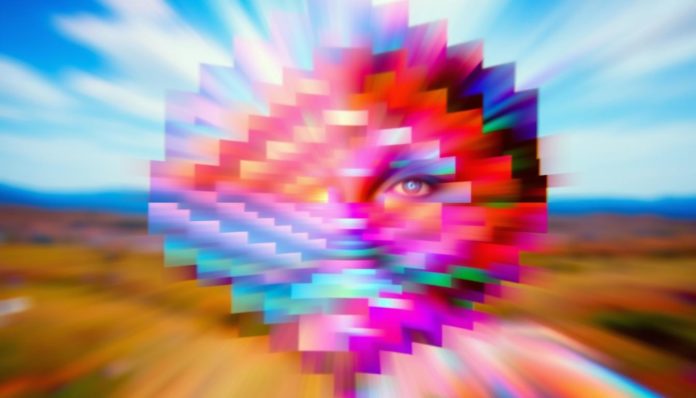Did you know palinopsia affects about 5 out of every 100,000 people? This shows how rare and complex this visual disorder is. It’s a condition where afterimages stay for a long time, not fading away.
Many people don’t know they have palinopsia. They just think it’s normal visual issues.
In this article, we’ll explore what palinopsia is. We’ll also look at how it’s different from other vision problems. Our goal is to help you understand this condition better.
What Is Palinopsia?
Palinopsia is when people see images that linger long after they’re gone. It’s confusing and can be frustrating. Unlike normal afterimages, palinopsia symptoms last longer and are more intense.

It’s important to know what causes palinopsia to find the right treatment. Changes in the brain and body can lead to this condition. These lasting images can really get in the way of daily life.
Palinopsia is different from normal afterimages because of how long and vivid the images stay. For example, looking at a bright object and then away might leave a quick afterimage for anyone. But for someone with palinopsia, the image stays longer and is more clear.
To understand palinopsia better, let’s compare it to normal afterimages:
| Aspect | Normal Afterimages | Palinopsia Symptoms |
|---|---|---|
| Duration | Short-lived (a few seconds) | Prolonged (minutes to hours) |
| Intensity | Moderate and fades quickly | Vivid and sustained |
| Impact on Daily Life | Minimal | Significant, often disruptive |
Finding the exact cause of palinopsia is hard. Doctors need to do detailed tests to figure it out. Knowing the cause helps doctors find the right treatment to help people with palinopsia live better.
Common Palinopsia Symptoms
Palinopsia can be unsettling. Knowing the typical symptoms is key. The most common symptoms are visual disturbances that affect daily life. Let’s explore these symptoms to understand what people with Palinopsia face.
Persistent Afterimages
Persistent afterimages are a common symptom of Palinopsia. People see an object’s image even after looking away. This can be both inconvenient and disorienting.
For example, looking at a bright light might leave its afterimage for a long time after turning away.

Visual Trails
Visual trails are another symptom of Palinopsia. These trails show as fading images behind moving objects. It can be hard to track fast-moving items because of these trails.
They overlap the current view with images from moments before. This disrupts smooth movement perception, making everyday tasks harder.
Causes of Palinopsia
Palinopsia can start from many reasons. It often comes from neurological issues or side effects of some medicines. Knowing these causes is key to finding the right treatment for it.
Neurological Conditions
Many neurological problems can lead to Palinopsia. Migraines, seizures, and brain injuries can mess with how we see things. This can cause afterimages and trails that don’t go away. Scientists are working hard to find treatments that fix the problem at its source.
Medication Side Effects
Some medicines can also cause Palinopsia. Drugs for mental health, epilepsy, and blood pressure can distort what we see. If you’re seeing weird things because of your meds, talk to your doctor. They can help find other treatments that won’t mess with your vision.
Diagnosing Palinopsia
Getting a precise palinopsia diagnosis starts with detailed vision tests and neurological checks. These steps help find the cause of the visual problems patients face.
Vision Tests
Eye doctors use various tests to find palinopsia. These include:
- Visual acuity tests to check how clear vision is
- Perimetry tests to see the full field of view
- Color vision tests to spot any color issues
- Optical coherence tomography (OCT) for retina images
These tests help rule out other eye problems. They give important clues for a correct palinopsia diagnosis.
Neurological Evaluations
Neurological checks are also key in diagnosing palinopsia. These steps are part of the process:
- Reviewing the patient’s history to understand symptoms
- Magnetic Resonance Imaging (MRI) for brain checks
- Electroencephalogram (EEG) to watch brain activity
- Neurological exam to check reflexes and motor skills
These evaluations are crucial. They help doctors tell palinopsia apart from other brain disorders.
Treating Palinopsia
Effective palinopsia treatment often combines medication and therapy. Knowing about these options can help manage symptoms. It can also improve daily life for those with visual disturbances.
Medication
Certain drugs can help with palinopsia symptoms. These include:
- Antiepileptic drugs
- Antidepressants
- Antipsychotic medications
These medications help by stabilizing brain activity. They also reduce the severity of visual problems.
Therapy
Therapy is also key in treating palinopsia. Vision therapy, for example, helps retrain the eyes. It improves how the brain processes visual information.
Occupational therapy helps adapt daily activities. It makes it easier to live with visual disturbances.
| Treatment Type | Description | Benefits |
|---|---|---|
| Medication | Includes antiepileptic drugs, antidepressants, and antipsychotics. | Reduces neural activity and visual disturbances. |
| Vision Therapy | Retrains the visual system to handle disturbances better. | Improves visual processing and symptom management. |
| Occupational Therapy | Adaptations for daily living activities. | Minimizes the impact of visual disturbances on daily life. |
Living with Palinopsia: Tips and Advice
Living with palinopsia can be tough, but there are ways to manage it. Here are some tips to help you live better with vision disorders.
Environmental adjustments: Making your environment better is key. Use softer lights to lessen afterimage harshness. Try to get natural light and avoid bright, flickering lights.
Coping mechanisms: Doing eye exercises can help with palinopsia. Try focusing on something far away for a few minutes. Also, take breaks from activities that strain your eyes, like reading or screen time.
- Use anti-glare screens on computers and phones.
- Adjust screen brightness to a comfortable level.
- Wear sunglasses outdoors to reduce light intensity.
Support systems: Getting help from doctors and support groups is important. Regular visits to eye doctors can help manage your condition.
Looking for online or in-person communities can also help. Forums and support groups offer emotional support and advice from others who face similar challenges.
| Concern | Suggested Action |
|---|---|
| Persistent Afterimages | Use of softer lighting, taking regular breaks |
| Visual Trails | Eye exercises, focus adjustments |
| Light Sensitivity | Wear sunglasses, adjust screen settings |
| Emotional Support | Join support groups, consult healthcare professionals |
By using these strategies, you can improve your life and manage palinopsia better. Understanding and adapting to your environment and condition are crucial for thriving with vision disorders.
Visual Disturbances vs. Palinopsia
It’s important to know the difference between visual disturbances and Palinopsia for proper diagnosis and treatment. Both involve vision problems, but they have unique features. For example, visual disturbances can cause blurriness, double vision, or light sensitivity.
Palinopsia, on the other hand, is mainly about seeing persistent afterimages and visual trails. This means a person might see an image even after looking away. This symptom is a key way to tell Palinopsia apart from other vision issues.
The causes of these conditions also differ. Visual disturbances can come from things like eye problems, migraines, or too much eye strain. But Palinopsia is often caused by neurological issues or side effects from medication.
The table below shows the main differences:
| Feature | Visual Disturbances | Palinopsia |
|---|---|---|
| Common Symptoms | Blurriness, Double Vision, Light Sensitivity | Persistent afterimages, Visual trails |
| Causes | Refractive Errors, Migraines, Eye Strain | Neurological Conditions, Medication Side Effects |
| Treatment Approaches | Glasses, Rest, Medication | Therapy, Medication |
| Diagnosis | Eye Exams, MRI | Vision Tests, Neurological Evaluations |
Understanding these differences is key to creating effective treatment plans. This ensures better care for those dealing with these vision problems.
Personal Stories: Life with Palinopsia
Living with palinopsia is tough. People with this disorder share their stories. They give us a peek into their daily lives and how they adapt.
“Every morning, I wake up to a world that seems slightly off-kilter,” says one patient. Their stories show us what it’s like to live with vision disorders. They help us understand how palinopsia affects people differently.
Many have found ways to cope with palinopsia. They use special techniques to deal with visual problems:
- Using tinted glasses to lessen the brightness of afterimages
- Implementing a consistent sleep schedule to minimize fatigue-related symptoms
- Engaging in mindfulness practices to handle the anxiety that often accompanies visual distortions
A long-time sufferer’s story highlights the importance of community support. Connecting with others who understand helps a lot. It offers emotional support and practical tips for dealing with symptoms.
These stories show that despite the challenges, people with vision disorders like palinopsia can lead fulfilling lives. Resilience and adaptability are key.
Latest Research on Palinopsia
Recent years have seen big steps forward in palinopsia research. Scientists are now better understanding this unique vision disorder. They’ve found specific brain patterns linked to palinopsia, helping them grasp its causes.
Thanks to new imaging and diagnostic tools, researchers can tell palinopsia apart from other vision issues. This is a big leap forward in studying this condition.
Researchers are also looking into new treatments for palinopsia. Pharmaceutical companies are working on medicines that target the brain’s affected areas. Early trials show some success, with patients seeing symptom relief.
Other non-drug treatments, like cognitive and visual therapy, are also being explored. These methods might help manage palinopsia symptoms.
Studies on vision disorders, including palinopsia, are ongoing. Researchers are looking into genetic and environmental factors that might cause it. This could lead to ways to prevent it and tailor treatments.
The work of scientists worldwide brings hope to those with palinopsia. Their discoveries and teamwork aim to improve life for those affected by this condition.
FAQ
What is palinopsia?
Palinopsia is a rare vision disorder. It makes objects stay visible after they’re gone. This is known as visual echoes.
What are the common symptoms of palinopsia?
Symptoms include afterimages that last too long. You see an object even after it’s gone. You might also see fading images behind moving things.
What causes palinopsia?
It can come from neurological issues like migraines or brain injuries. Some medicines can also cause it.
How is palinopsia diagnosed?
Doctors use vision tests to see the symptoms. They also do neurological checks to confirm it and rule out other problems.
What treatment options are available for palinopsia?
Treatments include medicines for the cause and therapy. Vision therapy helps with daily life.
How can individuals manage living with palinopsia?
Managing it means adjusting your environment and finding coping ways. Getting support from doctors and others helps too.
How does palinopsia differ from other visual disturbances?
Palinopsia is unique because of its afterimages and trails. It needs special diagnosis and treatment.
Are there personal stories from individuals living with palinopsia?
Yes, people share their experiences. Their stories show how it affects them and how they adapt.
What is the latest research on palinopsia?
New research is finding more about palinopsia. It looks at treatments and understanding the condition better.


